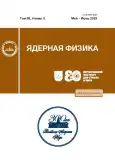Search for Bound States in \(\boldsymbol{\Xi^{-}nn}\)-, \(\boldsymbol{\Xi^{-}pn}\)- and \(\boldsymbol{\Xi^{-}pp}\)- Systems
- Autores: Egorov M.V.1
-
Afiliações:
- Faculty of Physics, Tomsk State University
- Edição: Volume 86, Nº 3 (2023)
- Páginas: 416-427
- Seção: ЭЛЕМЕНТАРНЫЕ ЧАСТИЦЫ И ПОЛЯ. Теория
- ##submission.datePublished##: 01.04.2023
- URL: https://rjsvd.com/0044-0027/article/view/674709
- DOI: https://doi.org/10.31857/S004400272303008X
- EDN: https://elibrary.ru/RKUYYC
- ID: 674709
Citar
Texto integral
Resumo
Search for bound states in @, @, and @ systems is performed by employing coupled homogeneous integral Faddeev equations written in terms of
-matrix components. Instead of the traditional partial-wave expansion, a direct integration with respect to angular variables is used in these equations, and three-body coupling in the phase space of each of the @–@–@, @–@–@, and @–@–@ systems is taken precisely into account within this approach. Two-body
matrices are the only ingredient of the proposed method. In the case of two-body @ interaction, they are found by solving the coupled Lippmann–Schwinger integral equations for the @–@–@ system in the (@, @) state, the @ system in the (@, @) state, the @–@ systemin the (@, @) state, and the @–@–@ system in the (@,@) state. An updated version of the ESC16 microscopic model is used to obtain two-body @, YY, and YN interactions generating @ matrices. Two-body NN @ nteraction is reconstructed on the basis of the charge-dependent Bonn model. Direct numerical calculations of the binding energy for the systems being considered clearly indicate that either of the @ and @ systems has one bound state with binding energies of 4.5 and 5.5 MeV, respectively, and that the @ system has two bound states with binding energies of 2.7 and 4.4 MeV.
Sobre autores
M. Egorov
Faculty of Physics, Tomsk State University
Autor responsável pela correspondência
Email: egorovphys@mail.ru
Tomsk, Russia
Bibliografia
- J. K. Ahn, S. Aoki, K. S. Chung, M. S. Chung, H. En’yo, T. Fukuda, H. Funahashi, Y. Goto, A. Higashi, M. Ieiri, T. Iijima, M. Iinuma, K. Imai, Y. Itow, J. M. Lee, S. Makino, et al., Phys. Lett. B 633, 214 (2006); https://doi.org/10.1016/j.physletb.2005.12.057
- T. Tamagawa, J. K. Ahn, S. Ajimura, H. Akikawa, B. Bassalleck, A. Berdoz, D. Carman, R. E. Chrien, C. A. Davis, P. Eugenio, H. Fischer, G. B. Franklin, J. Franz, T. Fukuda, L. Gan, L. Tang, et al., Nucl. Phys. A 691, 234 (2001); https://doi.org/10.1016/S0375-9474(01)01035-1
- Y. Yamamoto, T. Tamagawa, T. Fukuda, and T. Motoba, Prog. Theor. Phys. 106, 363 (2001); https://doi.org/10.1143/PTP.106.363
- K. Nakazawa, Y. Endo, S. Fukunaga, K. Hoshino, S. H. Hwang, K. Imai, H. Ito, K. Itonaga, T. Kanda, M. Kawasaki, J. H. Kim, S. Kinbara, H. Kobayashi, A. Mishina, S. Ogawa, and H. Shibuya, Prog. Theor. Exp. Phys. 2015, 033D02 (2015); https://doi.org/10.1093/ptep/ptv008
- K. Aoki et al. (J-PARC Collab.), arXiv: 2110.04462 [nucl-ex].
- H. Garcilazo, A. Valcarce, and T. F. Caramés, J. Phys. G: Nucl. Part. Phys. 41, 095103 (2014); https://doi.org/10.1088/0954-3899/41/9/095103
- H. Garcilazo, A. Valcarce, and T. F. Caramés, J. Phys. G: Nucl. Part. Phys. 42, 025103 (2015); https://doi.org/10.1088/0954-3899/42/2/025103
- H. Garcilazo, Phys. Rev. C 93, 024001 (2016); https://doi.org/10.1103/PhysRevC.93.024001
- H. Garcilazo and A. Valcarce, Phys. Rev. C 93, 034001 (2016); https://doi.org/10.1103/PhysRevC.93.034001
- I. Filikhin, V. Suslov, and B. Vlahovic, Math. Model. Geom. 5, 1 (2017); https://doi.org/10.48550/arXiv.1705.03446
- E. Hiyama, K. Sasaki, T. Miyamoto, D. Doi, T. Hatsuda, Y. Yamamoto, and Th. A. Rijken, Phys. Rev. Lett. 124, 092501 (2020); https://doi.org/10.1103/PhysRevLett.124.092501
- K. Miyagawa and M. Kohno, Few Body Syst. 62, 65 (2021).
- M. N. Nagels, Th. A. Rijken, and Y. Yamamoto, arXiv: 1504.02634 [nucl-th].
- M. N. Nagels, Th. A. Rijken, and Y. Yamamoto, Phys. Rev. C 102, 054003 (2020); https://doi.org/10.1103/PhysRevC.102.054003
- L. D. Faddeev, Sov. Phys. JETP 12, 1014 (1961).
- H. Liu, Ch. Elster, and W. Glockle, Phys. Rev. C 72, 054003 (2005); https://doi.org/10.1103/PhysRevC.72.054003
- M. Egorov, Phys. Rev. C 107, 014611(2023); https://doi.org/10.1103/PhysRevC.107.014611, см. также препринт: https://www.researchsquare.com/article/rs-2021229/v1
- J. Revai and N. V. Shevchenko, Phys. Rev. C 90, 034004 (2014); https://doi.org/10.1103/PhysRevC.90.034004
- W. Glöckle, H. Witała, D. Hüber, H. Kamada, and J. Golak, Phys. Rep. 274, 107 (1996); https://doi.org/ 10.1016/0370-1573(95)00085-2
- J. Haidenbauer, Y. Koike, and W. Plessas, Phys. Rev. C 33, 439 (1986); https://doi.org/10.1103/PhysRevC.33.439
- M. M. Nagels, Th. A. Rijken, and Y. Yamamoto, Phys. Rev. C 99, 044003 (2019); https://doi.org/10.1103/PhysRevC.99.044003; http://nn-online.org
- M. Egorov and V. Postnikov, Nucl. Phys. A 1009, 122172 (2021); https://doi.org/10.1016/j.nuclphysa.2021.122172
- J. Adam et al. (STAR Collab.), Nat. Phys. 16, 409 (2020); https://doi.org/10.1038/s41567-020-0799-7
- B. Sechi-Zorn, B. Kehoe, and J. Twitty, Phys. Rev. 175, 1735 (1968); https://doi.org/10.1103/PhysRev.175.1735
- G. Alexander, U. Karshon, A. Shapira, and G. Yekutiely, Phys. Rev. 173, 1452 (1968); https://doi.org/10.1103/PhysRev.173.1452
- R. Engelmann, H. Filthuth, V. Hepp, and E. Kluge, Phys. Lett. 21, 587 (1968); https://doi.org/10.1016/0031-9163(66)91310-2
- F. Eisele, H. Filthuth, W. Foehlisch, V. Hepp, and G. Zech, Phys. Lett. B 37, 204 (1971); https://doi.org/10.1016/0370-2693(71)90053-0
- H. Garcilazo, A. Valcarce, and J. Vijande, Phys. Rev. C 94, 024002 (2016); https://doi.org/10.1103/PhysRevC.94.024002
Arquivos suplementares










